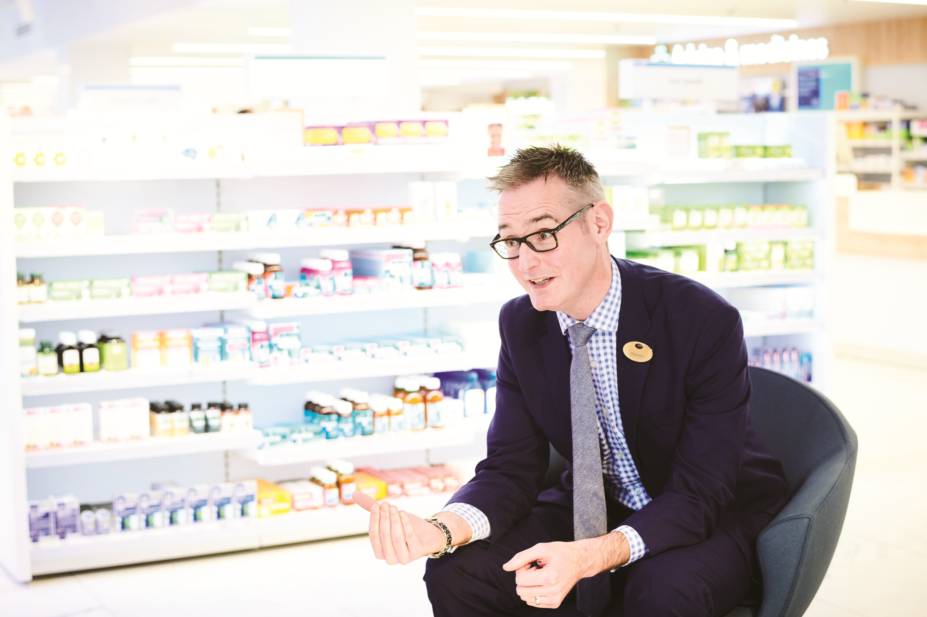
Paul Stuart
As things stand, Boots likes to boast that 90% of people in the UK are just ten minutes away from one of its pharmacy stores. While the multiple’s recent admission that it plans to shut 200 stores might alter this, it will still comfortably be the largest pharmacy presence on the UK high street.
However, as its traditional pharmacy service shows signs of struggle, the meteoric rise of online-only pharmacies could pose another threat to Boots’s dominance, but Stephen Watkins, the company’s director of pharmacy items (who is also overseeing the chain’s digital transformation), is upbeat.
As he meets The Pharmaceutical Journal, he’s sitting in the pharmacy waiting area at the multiple’s brand new all-singing, all-dancing flagship store in the heart of London’s Covent Garden. The new store, which opened in June 2019, includes fast-track lanes that guarantee patients the ability to pick up their online-ordered prescriptions in two minutes or less. Patients looking for an even speedier transaction can use one of the company’s three prescription pick-up lockers. The smart new store is the first step in a six-month trial to see how patients respond to new ways of interacting with their pharmacy.
For a company that saw its profits fall by a fifth in 2018, spending tens of thousands of pounds on lockers and unveiling a revamped shop design could seem counterintuitive. But Watkins is unfazed, insisting on the power of convenience and accessibility in attracting more customers, while promising a community pharmacy that is fit for the future.
How concerned is Boots about the growth of online-only pharmacies?
I wouldn’t say we are concerned, I would say it’s a good opportunity. This is definitely the right time to expand into the market. If you look at the online market, it’s doubled over the past year but the uptake is still relatively slow. Around 9% of patients order their prescriptions online.
The majority of our patients who order online also collect in store, because they like the care that our colleagues can bring
If you look at banking, it’s probably a similar type of journey and 86% of people now use their mobile or have an app to interact with their bank. I think this will be the journey for pharmacy as well.
What we know is that the majority of our patients who order online also collect in store because they like the care that our colleagues can bring. So how do we use digital but also have the bricks and mortar physical space? It’s really important that you have a presence online, but also provide in-person care.
Around 90% of the population is within ten minutes of a Boots store. In my mind, nobody else can offer that accessibility as well as a market-leading online offer.
Do you think you’re at the forefront of where multiple pharmacies are heading in terms of growing the online side of the business?
I wouldn’t say that we’re at the front, but I would say we are moving in the right direction. I think it shows a statement of intent that we are moving into that place. We’re not at the forefront but we are definitely transforming pharmacy.
What do you think Boots could do better digitally?
We started with the launch of the free online NHS repeat prescription service. When that launched in April 2019, if I’m honest, it was quite clunky — it was very cumbersome. We are continuing to make changes and we are looking at making changes every couple of weeks. That’s what will make a difference.
Boots has previously said it is creating “a market-leading omnichannel pharmacy experience”. What else will this experience offer patients?
In July 2019, we’re looking at bringing out a GP link functionality, which will give patients the ability to see the mirror image of their patient medication record from their GP and order [prescriptions] directly from it.
This will help to speed up the journey from both a patient and pharmacy perspective. We also believe it will help GPs from an efficiency perspective. We’re working with a GP in Norfolk to say, ‘How does this system benefit you?’ ‘How does it work alongside what you already have?’ — because we need to make sure it works in conjunction with the NHS and not in competition.
I see wellness and how we link [the pharmacy experience] all together so that it’s less about the treatment and more about the prevention and help with medical adherence, help with long-term conditions. That definitely fits in with the long-term plan of where the NHS wants pharmacy to play and that’s how I see omnichannels coming together rather than being siloed.
Boots launched a new repeat prescription feature in its app in May 2019. How do you expect this to compete with that of the NHS’s own app?
I see the apps working in tandem. The slight differences between what the NHS app will be able to do and what the Boots app will be able to do will be different notifications for our patients and, in the future, Boots’s ability to track and trace where your prescription is.
I definitely see a future where patients are able to book a GP appointment through the [Boots] app. We’ve got our patient medication record system, Columbus, which has been rolled out in nearly 600 stores already, and it’ll be in 1,000 stores by the end of August 2019.
Once Columbus rolls out, we’ll have two key things: one is a central view of the patient; and second is a central view of stock. What I’d like to be able to do is say to a patient, ‘we have 21 amoxicillin (or whatever) in stock’, and they will be able to see that at the point they’re looking to order it.
I’d love to be able to open that up to GPs so that GPs can have that visibility to say: “I’ll prescribe this and the store in Covent Garden has that in stock — you can go and get it and the wait time is five to ten minutes.” We’re not there yet. But that’s definitely where I see the future of that convenience and accessibility coming out.
Why is Boots focusing on digital technology that will ultimately reduce face time?
I see it slightly differently. I see it as there are certain patients who are on medication that they just want to get, and be in and out. Nothing has changed. The pharmacist doesn’t necessarily need to see them. But as they grow older, they will definitely need that face-to-face consultation or to ask a question.
I see the use of technology as providing a bigger increase in face-to-face consultations because we’re being given time back
The millennials of today are the older population of tomorrow, and their needs will increase as they take more medicines. That’s where there will definitely be more of a requirement for face-to-face consultation and it’s just having the flexibility to be there.
Things such as lockers or express pick-up lanes give us that ability to be able to take that time that our colleagues will then save and invest it in spending time with patients who really need it. I see the use of technology as providing a bigger increase in face-to-face consultations because we’re being given time back.
How are pharmacists going to be able to intervene if they feel that patients using the lockers need to have a face-to-face chat with the pharmacist?
With the lockers, we’ll be able to put a message on the prescription bag telling patients that we need to speak to them if required. If it’s something where we don’t think it should go into the locker and we want to have a conversation with a patient, we’ll have their phone number to be able to text the person to say: “Rather than the locker, can you come and collect it from the express pick up,” or: “Can you come to speak to the pharmacist?” Or, if it’s something urgent, I would fully expect that the pharmacist would make the decision to call the patient.
Boots reported an almost 20% decline in its 2018 profits compared with 2017. How does Boots’s digital agenda fit in with plans to mitigate any further losses?
What we’re doing is about the transformation of pharmacy. It’s about how we transform that patient journey so that we attract more patients to come to us. So I see it as investing for the future and investing in being more convenient, and more accessible, than anybody else on the high street.
Will the focus on online dispensing impact the number of jobs available for pharmacists in Boots stores?
Not that I can see, no.
How will Boots pharmacies be using technology differently in ten years?
How do we use patient data for prevention rather than treatment? I think that’s where the next five to ten years will move to. That will help to alleviate some of the pressures on the NHS — how we use technology that’s already out there or technology that we don’t even know about at this point in time to provide a different level of care. I think that the advancements in digital technology are huge. Being able to bring all that together is going to be a game changer.
What share of the dispensing business do you predict will be done through Boots’s online pharmacy arm in five to ten years?
It’s hard to tell at this point in time because it’s small overall. As a market, it’s around 2%. I definitely think that percentage will continue to grow — it could be ten times as big, it could be five times as big, I couldn’t really say. But I think it will definitely grow exponentially because that’s what patients are looking for — that convenience.


